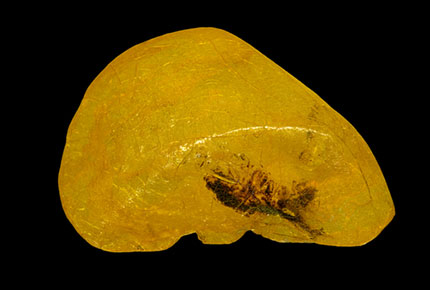Encapsulating History
The Center for Lebanese Heritage examines its national treasure: amber.
Could Lebanon’s amber have been the inspiration for the 1993 box office phenomenon Jurassic Park? Experts brought together by LAU’s Center for Lebanese Heritage (CLH) during its series of monthly lectures deliberated the possibility and the country’s unique wealth of this fossilized tree resin.
Poet Henri Zoghaib, CLH director, brought together Dany Azar, a professor at the Lebanese University’s Faculty of Science, renowned film director, Philippe Aractingi and the sales manager of Nsouli Jewelry, Fadi Zein al-abdine to deliberate the possibility and put this national treasure into perspective in a lecture entitled “Lebanese Amber: a Rare Treasure.”
Azar recounted how an AUB professor, Aftim Acra, discovered, in 1962, one of the world’s oldest amber stones with biological inclusions in south Lebanon’s Jezzine. “His friend and colleague was Paul Whalley, who in the late 70s worked in the Natural History Museum of London,” he explained, continuing, “It is believed that a conversation between the two on the possible extraction of DNA from the insect fossilized in the amber made its way to American writer Michael Crichton.” And later gave birth to Steven Spielberg’s Jurassic Park.
The Blockbuster movie used groundbreaking computer-generated imagery in conjunction with life-sized animatronic dinosaurs. “Jurassic Park grossed over USD 900 million worldwide to become the highest-grossing film at the time and put the spotlight on the importance of amber,” Aractingi elucidated.
Although extracting DNA from the amber is impossible, Azar continues to search for ambers to better understand how the planet may have looked like millions of years ago. With over 400 sites worldwide, the findings are like looking back in time. “These ambers are like a window into the past,” he enthuses, adding, “Through them we could see what life may have been like.” One importance of history for Azar is that it opens the door to the imagination.
He traced amber to the Phoenicians, who were the first to collect it. They then traded it throughout the world in exchange for bronze according to recent archaeological discoveries. Amber outcrops cover about 10 percent of Lebanon’s territory and are found in many parts of the country, says Azar.
Even after millions of years, one can see and sometimes according to Azar hear biological inclusions inside ambers. When the resin falls from a tree on a living organism, it cuts the oxygen from the organism. Whatever is caught in the amber, be it an insect, pollen or simply an air or water bubble - is frozen in time.
Apart from its historical aspect, amber is a treasure of another kind, one coveted as an adornment. “Amber is soft, warm and light, making it the perfect gem stone,” says Zein al-Abdine, concluding, “Amber increases in value with the rarity and perfection of the entrapped object.”
For Dr. George Tohme, president of the National Council for Scientific Research, Lebanon’s ambers are a “national treasure” and their preservation should be a priority. “There is a need to protect the amber in Lebanon from extinction,” he stressed.
More
Latest Stories
- LAU Nursing Camp Opens Eyes, Hearts and Futures
- Meet Dr. Zeina Khouri-Stevens, Executive Vice President for Health Services
- LAU Family Medicine Graduates to Benefit from a Partnership With Nova Scotia
- AKSOB Assistant Professor Shares Her Vision for the Future of Learning
- LAU Simulation Models Celebrate 20 Years of Learning, Leadership and Service
- The School of Engineering Hosts the Lebanese Electromagnetics Day
- LAU Stands Out on the Sustainability Scores
- Michael Haddad Walks Again for Climate Change and Food Security


